Understand the Role of Effective Meetings - Business Decision Making - ثاني ثانوي
Part 1
Chapter1: Identifying and Defining Problems
Chapter2: Solving the Problem
Chapter3: Thinking Critically
Chapter4: Group Decision Making and Problem Solving
Chapter5: Decision Support Tools
Part 2
Chapter 6: Decision-Making Processes in Organizations
Chapter 7: Managing Teams to Support Decisions in Organizations
Chapter 8: Organizational Communication and Decision Making
Chapter 9: Using Data to Support the Decision-making Process
Part 3
Chapter 10: Decision Support System Fundamentals
Chapter 12: The Car Production Project
Chapter 13: The Ski Resort Project
Chapter 14: The Electric Car Project
Chapter 15: The Airline Project
Lesson 4 Chapter 8 www.ien.edu.sa Understand the Role of Effective Meetings 4-1 Understanding the Role of Meetings Meetings are common in most organizations. Professional staff and managers typ- ically attend a few meetings every week. Senior executives regularly spend over half their working hours in meetings and conferences. There are many reasons for holding a meeting as shown in Table 8-3. Many meetings occur in a physical loca- tion where participants can talk face to face. Electronic communications also make it possible to have a virtual meeting with people who are in different places. In either case, meetings provide valuable contact with others and let you observe the verbal and nonverbal cues of other participants. 252 8 Chapter رة ا Ministry of Education 2024-1446 Business Decision Making S1 S2 S3.indb 252 DEFINITION Meetings: Three or more people get together at a common time to discuss, debate, decide, plan, and solve problems related to a compa- ny goal. TABLE 8-3: Determining whether to hold a meeting scenario: Team members attended a conference on the latest Web technologies and now want to share what they learned You reviewed the Web sites of other travel companies and want to report on what you found A team member completed a preliminary outline of the new Web site and wants to ask for feedback Your manager announced a new Internet usage policy, and you want to discuss how it affects the team Some team members have selected two possible designs for the updated Web site and want to seek consensus from the entire team The software the team is using to create Web pages is too difficult, which is causing delays The team leader wants to invite members to attend a team meeting hold meeting send written message You need to tell everyone on your team that a meeting is being postponed Team members need to review the details of a plan ✓ The team leader wants to remind everyone about due dates they agreed to meet 30/06/2023 14:28
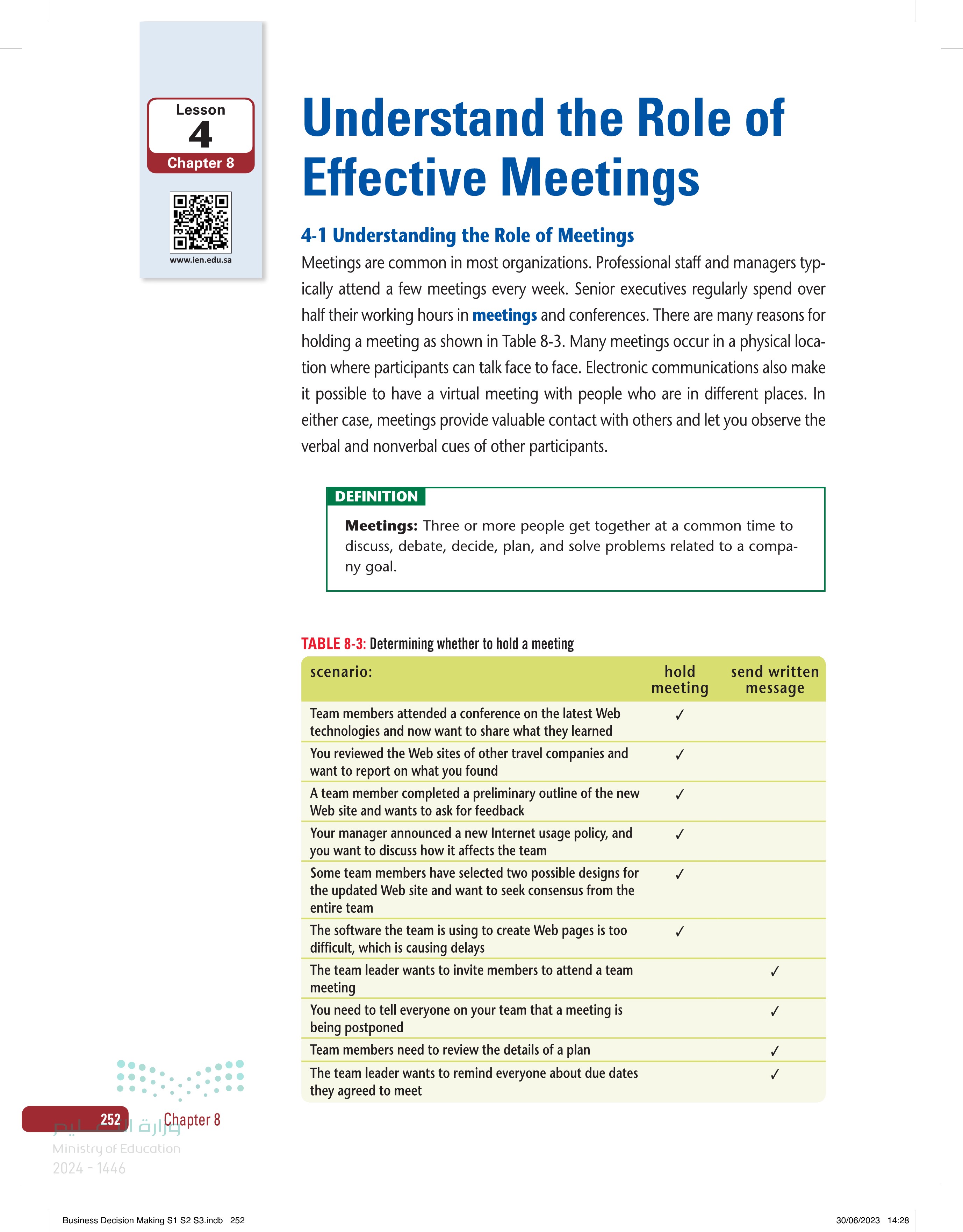
Understand the Role of Effective Meetings
QUICK TIP Update meetings are also called status meetings or department meetings. Teams hold meetings for the following reasons: 1. Sharing information Teams hold meetings to exchange information. Informational meetings pro- vide opportunities to ask and answer questions, pool information, and make sure everyone hears and understands the same news. For example, you might hold an informational meeting to introduce a new team member, announce a team success, report on updates to a project, or provide limited training. Informational meetings can be called only when necessary or sched- uled on a regular basis. 2. Solving problems When a team faces a complicated problem, it might hold a meeting to dis- cuss and resolve the problem. Team leaders might call a problem-solving meeting as soon as they learn about a problem. For this reason, they do not provide an agenda in advance or support information during the meeting. In some cases, the meeting is the first time that many participants learn about the problem. Usually, the team assesses the scope and impact of the prob- lem, and then the group works to identify possible solutions. 3. Planning Teams often use meetings to make plans. They organize and coordinate team activities and tasks. Unlike problem-solving meetings, team leaders should organize planning meetings in advance. They should distribute material to team members before the meeting so everyone is prepared to participate. 4. Providing updates Teams often use regularly scheduled meetings to keep all members up to date on the team's progress. Typically, a team meets at least once a week. The tone of these meetings is usually informal, to encourage open commu- nication. Some update meetings are feedback meetings, where participants have the chance to report their progress on assigned tasks. They can also discuss problems and ask for suggestions to solve the problems. Other update meetings are feedforward meetings, where participants look ahead, instead of looking toward the past. In feedforward meetings, teams discuss schedules for the immediate future and coordinate activities. 5. Making decisions Teams occasionally need to meet so they can work cooperatively on a deci- sion. Examples of these meetings include reviewing applications to hire an وزارة التعليم Ministry of Education 2024-1446 Business Decision Making S1 S2 S3.indb 253 Organizational Communication and Decision Making 253 30/06/2023 14:28
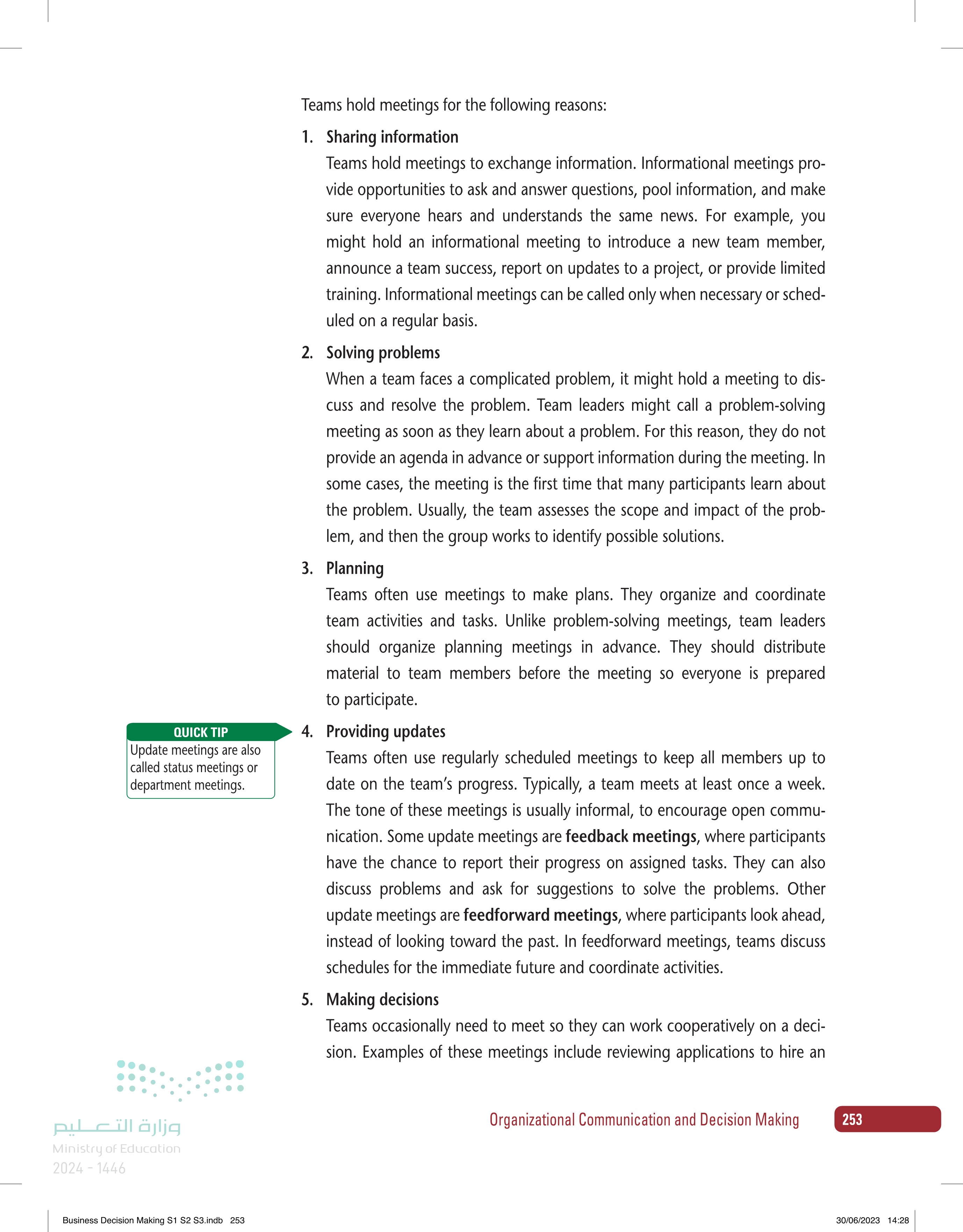
Sharing information
Solving problems
Planning
Providing updates
Making decisions
Update meetings are also called status meetings or department meetings
YOU TRY IT employee, setting goals for the next stage of a project, or evaluating bids from prospective contractors. In each case, the goal of the meeting is to make a decision. Check that you understand the role of meetings in organizations. Complete the following steps. 1. Read the following text. Specialty Travel is updating its policy manual for employees. Jamila formed a team led by Yasser to update the manual. The team meets every week from 9:30 to 10:30 am in the West Conference Room. The next meeting is on October 15, 2024. After Jamila makes her opening remarks, Asif wants to report on the current company manual. During the discussion, he wants to identify the strengths of the current manual and sections to change. He estimates 15 minutes for this part of the meeting. Next, Hamad will lead a discussion on vacation policies for about 17 min- utes, concluding with a vote. The team as a whole will discuss the policy area to study for next week, review deadlines, and assign tasks and responsibili- ties. This should take about 7 minutes. Asif wants to take a few minutes to update the action plan, and then Mariam will open the discussion to the team for the last 10 minutes of the meeting. As always, they will discuss successes and problems during this time. 2. In your notebook, write down which elements of the meeting described above meet the following purposes for meetings: 254 8 Chapter رة ا Ministry of Education 2024-1446 Business Decision Making S1 S2 S3.indb 254 • sharing information • solving a problem • planning • providing updates . making decisions. 4-2 Planning Effective Meetings Effective meetings are a valuable use of the participants' time. Ineffective meetings are unproductive and frustrating. The difference between the two often comes down to the planning that comes before the meeting. To run an effective meet- 30/06/2023 14:28
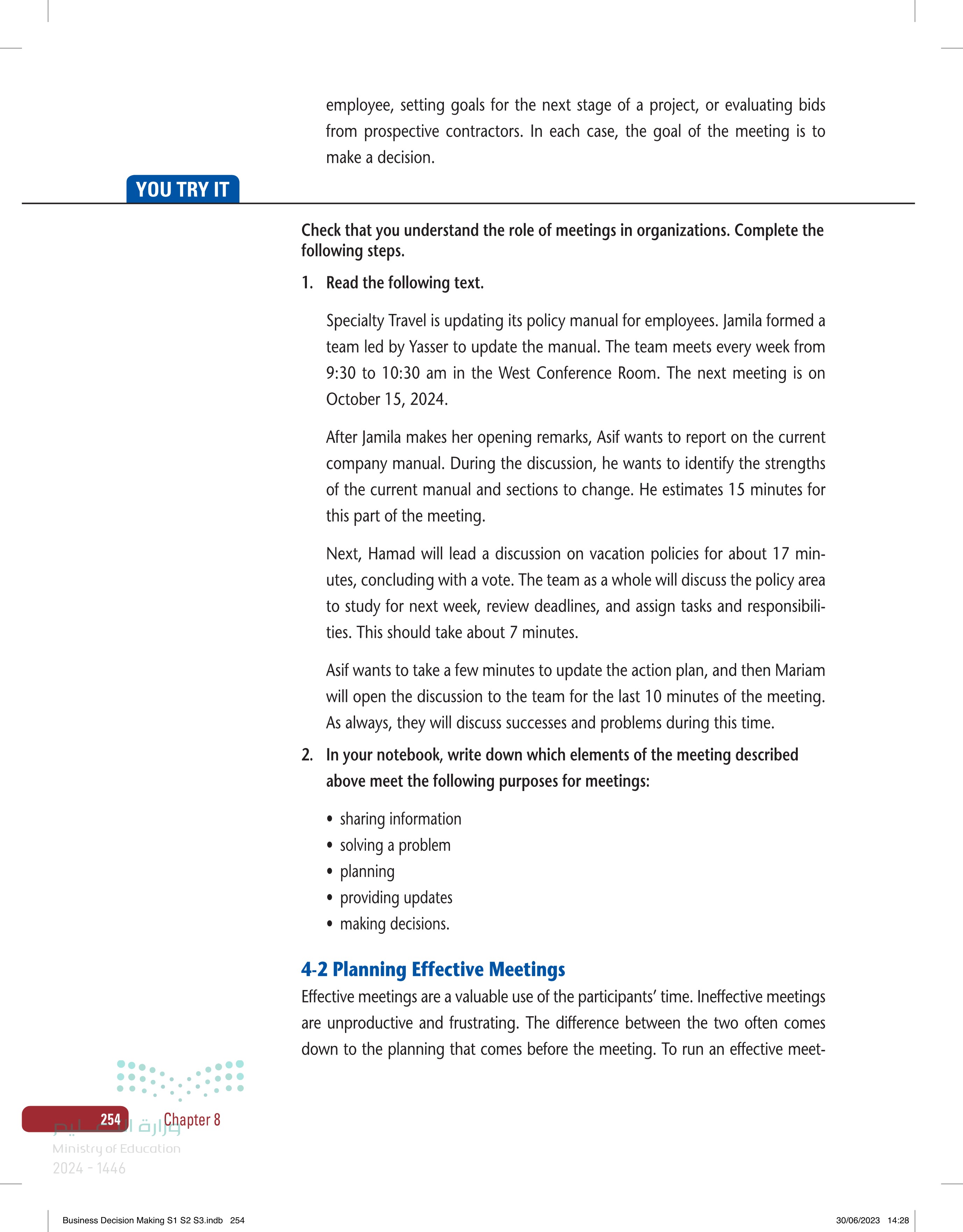
Making decisions
Check that you understand the role of meetings in organizations. Complete the following steps
In your notebook, write down which elements of the meeting described above meet the following purposes for meetings
Planning Effective Meetings
| QUICK TIP Call attendees personally if you want to be sure they will attend. ing, you need to plan who will attend and what you will discuss. When planning a meeting, consider the following: 1. Start with the objective Although you might hold meetings for different reasons, they each have a major objective. Start by defining the purpose of the meeting. You should be able to express the purpose in a few words. Don't start planning the meeting until you have a clear idea of its goal. 2. Make sure you need a meeting Some organizations prefer meetings to other types of communication and hold them frequently. Keep in mind that a meeting is expensive because it takes the time of all the participants. If someone has to travel to participate in the meeting, it becomes even more costly. Sometimes you can accomplish your objective without having everyone get together. Could an e-mail mes- sage, online discussion, or memo meet your goals? If so, try to use them before calling a meeting. 3. Identify key participants If you decide that a meeting is the best way to meet your goal, decide who should participate. Ask yourself who needs to attend to make the meeting successful. The purpose of the meeting often determines the number of peo- ple to invite. See Figure 8-9. If some participants will present information or play an active role in the meeting, give them time to prepare. If others would directly benefit from attending, add them to your invitation list. FIGURE 8-9: Maximum number of meeting participants وزارة التعليم Ministry of Education 2024-1446 Business Decision Making S1 S2 S3.indb 255 50 or more Up to 30 participants Maximum meeting participants 60 >50 40 No more than ten participants 30 20 10 No more than five participants 0 Solve problems or make important Identify problems decisions Present and review information Motivate participants Meeting purpose Organizational Communication and Decision Making 255 30/06/2023 14:28
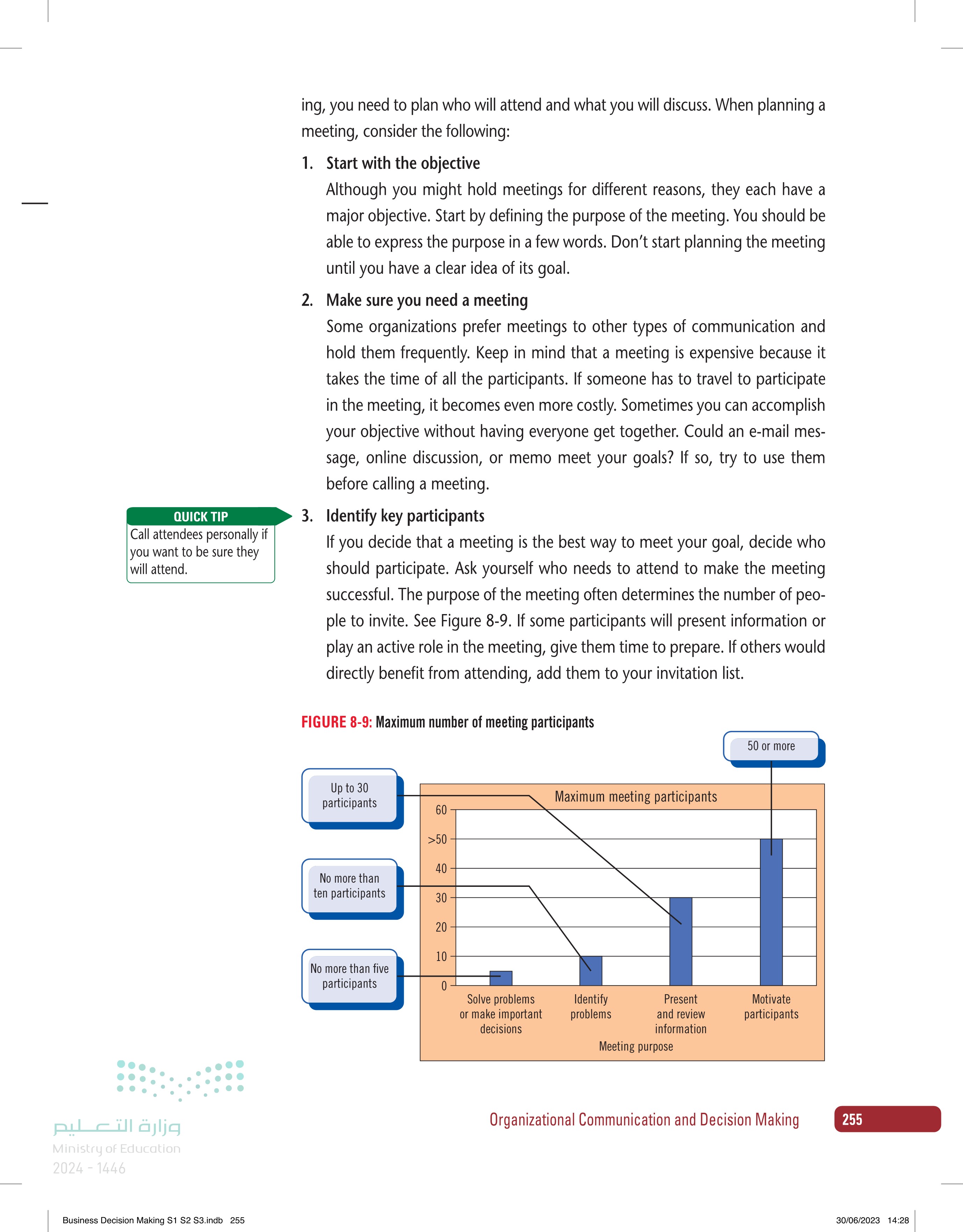
Start with the objective
Make sure you need a meeting
Identify key participants
Maximum number of meeting participants
Call attendees personally if you want to be sure they will attend
QUICK TIP Add only appropriate items to the agenda. 4. Distribute an agenda and information in advance At least two days before the meeting, send out an agenda. An example is shown in Figure 8-10. Include other information such as reports that partici- pants should read before the meeting. Never start a meeting by passing out materials such as copies of documents or presentation slides. These are dis- tractions and may disrupt your meeting. You want to give people enough time to get prepared and come to the meeting ready to work. You can also ask people what they want to discuss. Add these items to the agenda. Give people something to do so they become interested in the meeting and its outcome. DEFINITION Agenda: An outline or a list of topics that will be discussed during the meeting. FIGURE 8-10: Outline for a meeting agenda AGENDA Meeting Title Annual reports discussion Date 20-12-2022 Start time: 10:00 a.m. End time: 12:00 p.m. Invited to the meeting by Head of Department Mr Nayef: Reem Yaser Nawaf Please read: Please bring: 10:00 a.m.-10:30 a.m. 10:30a.m.-11:15 a.m. Previous reports Completion reports Review of first report Item 1 | Presenter: Reem 11:15 a.m.-12.00 p.m. Additional guidelines: None Meetings Office Review of second report Item 2 Presenter: Yasser Meetings Office Third Report Review Item 3 | Presenter Nawaf Meetings Office QUICK TIP Try to locate the meeting close to as many people as you can-not somewhere that is only convenient for you. 5. Choose an appropriate setting Select a time and place that is convenient for most of the attendees. Be sen- sitive to other obligations and scheduling conflicts as you select a meeting time. 256 8 Chapter رة ا Ministry of Education 2024-1446 Business Decision Making S1 S2 S3.indb 256 30/06/2023 14:28
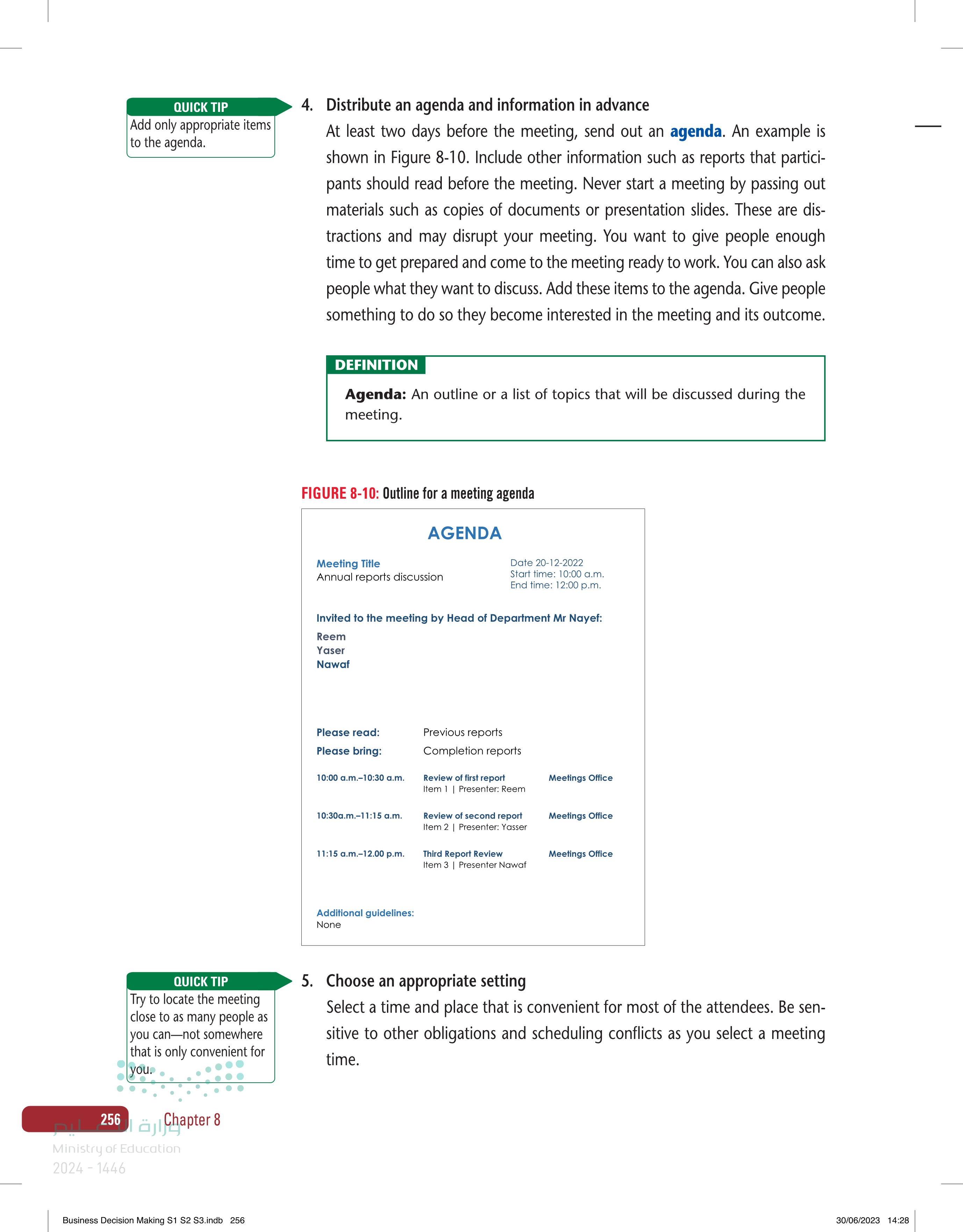
Distribute an agenda and information in advance
Choose an appropriate setting
YOU TRY IT Practice planning effective meetings. Complete the following steps. 1. Maha is preparing for a meeting of the Specialty Travel Policies team and wants to conduct the meeting effectively. Read the following list of meeting activities. Description 1. Arrive a few minutes after everyone else so they have a chance to mingle 2. Start the meeting on time, even if some people have not yet arrived 3. Hand out an agenda during the meeting, but tell everyone that they can talk about any subject that comes up 4. So that no one else is burdened with tasks, talk for most of the meeting time yourself 5. Schedule more than one speaker or presenter 6. Wait while everyone settles down, and then start the meeting about 10 minutes after the scheduled time 7. Visit the meeting room ahead of time and adjust the seating, lighting, and temperature so that everyone is comfortable 8. Distribute an agenda a few days before the meeting and refer to it during the meeting to keep everyone on time Effective way to manage the meeting? 2. In your notebook, make a list of tasks 1-8 and write Yes or No against each number according to whether each of the above points is an effective way to manage the meeting. Explain your answers. وزارة التعليم Ministry of Education 2024-1446 Business Decision Making S1 S2 S3.indb 257 Organizational Communication and Decision Making 257 30/06/2023 14:28
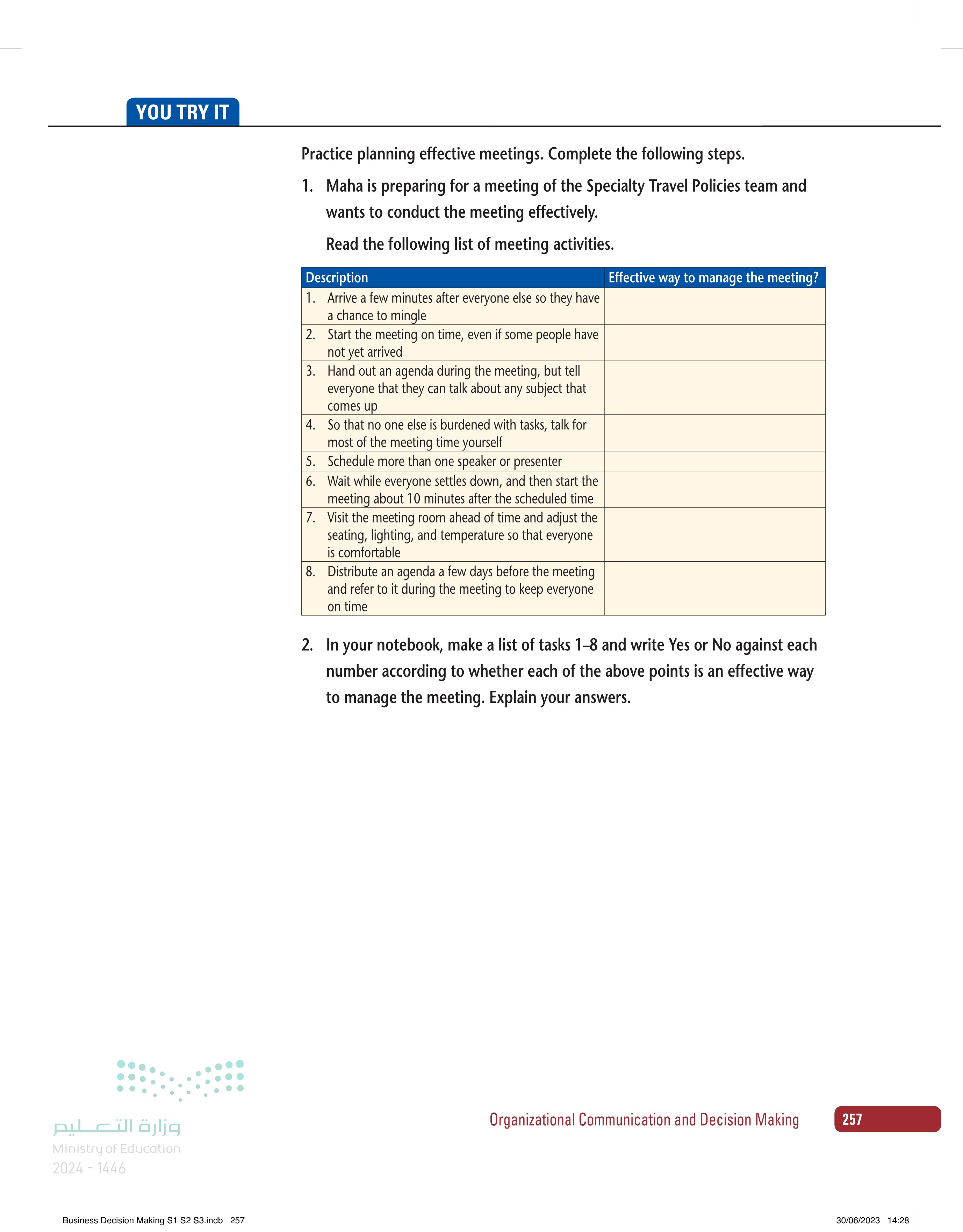
Maha is preparing for a meeting of the Specialty Travel Policies team and wants to conduct the meeting effectively
REVIEW QUESTIONS 1. In which of the following situations should you not hold a meeting? a. Team members want to report what they learned b. Team members need to review the details of a plan c. You want to discuss a new policy with the team d. Team members want to seek consensus about a decision 2. Which of the following situations is not the role of a meeting? a. Discuss and solve problems related to a company goal b. To meet colleagues face to face c. To enable contact and observe the verbal and nonverbal language used d. To remind everyone about due dates that have been agreed 3. At least two days before the meeting, the meeting leader should send out a(n): a. action plan b. minutes document c. schedule d. agenda 4. How many people can you invite to a motivational meeting? a. Up to five b. Up to ten c. 30 d. 50 or more 258 8 Chapter رة ا Ministry of Education 2024-1446 Business Decision Making S1 S2 S3.indb 258 30/06/2023 14:28
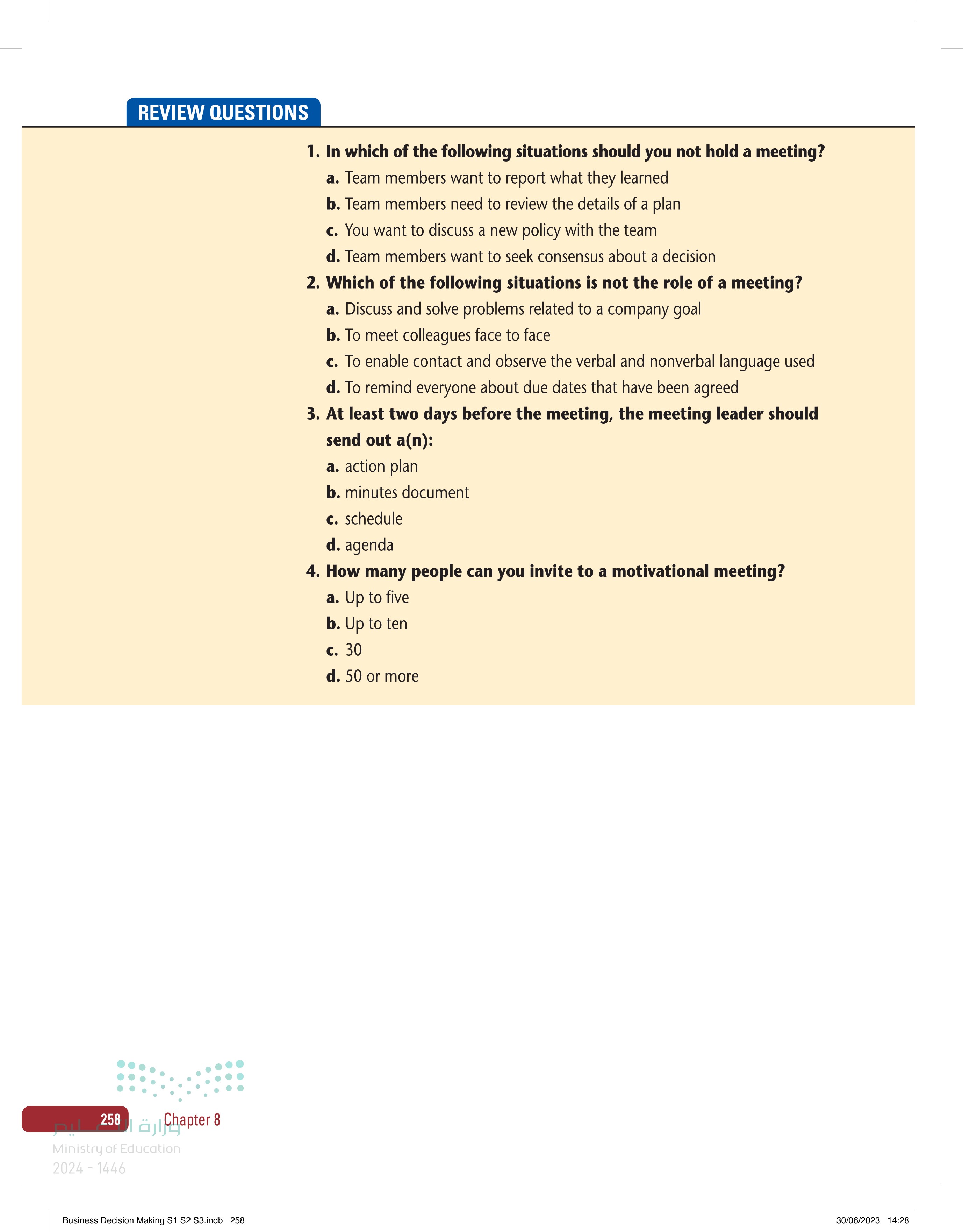
At least two days before the meeting, the meeting leader should send out a(n)
Which of the following situations is not the role of a meeting
In which of the following situations should you not hold a meeting
How many people can you invite to a motivational meeting?






